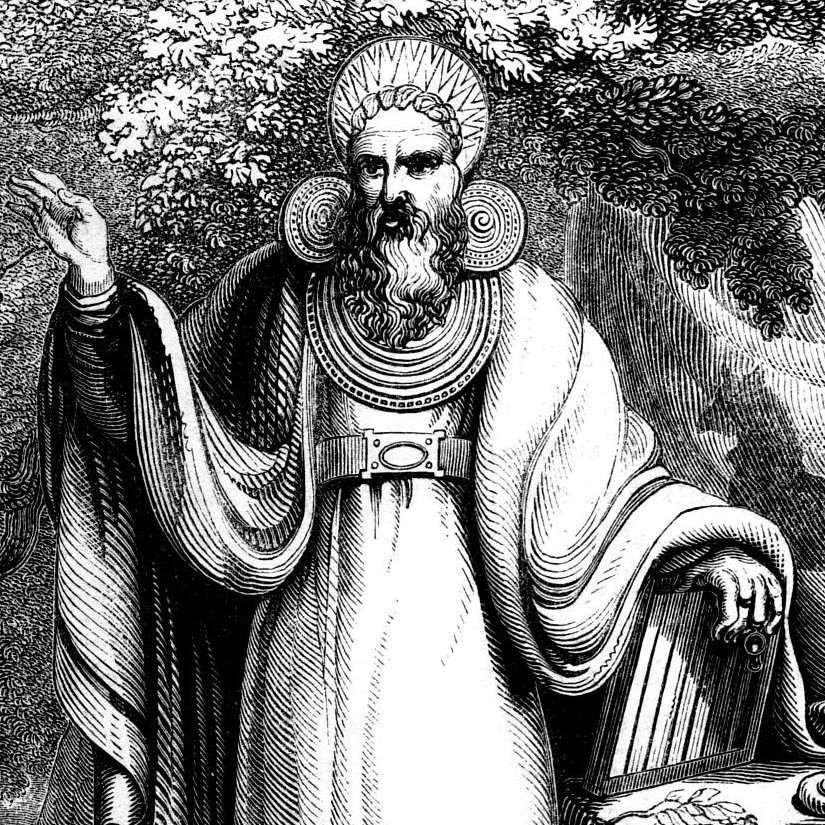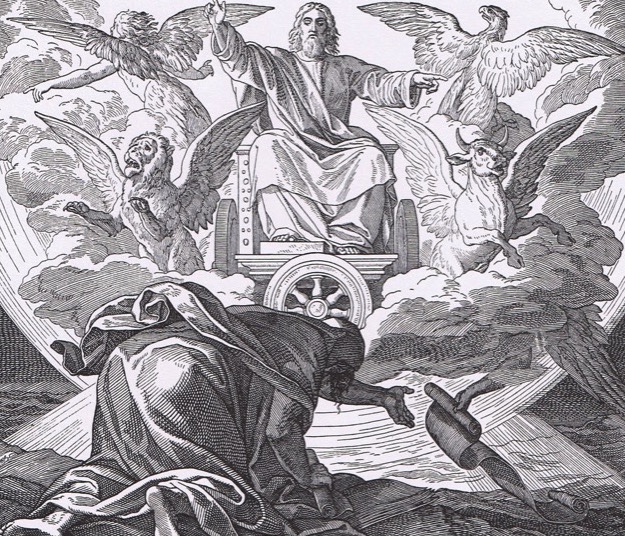The narrative of Muhammad gets more details from the later biography of Ibn Ishaq. There are multiple versions of the story of the revelation in the cave of Hira, but two in particular give us relevant information.
‘O ‘Ubayd tell us how began the prophethood which was first bestowed on the apostle when Gabriel came to him.’ And ‘Ubayd in my presence related to ‘Abdullah and those with him as follows: The apostle would pray in seclusion on Hira’ every year for a month to practise tahannuth as was the custom of Quraysh in heathen days. Tahannuth is religious devotion. …
Wahb b. Kaisan told me that ‘Ubayd said to him:
Every year during that month the apostle would pray in seclusion and give food to the poor that came to him. And when he completed the month and returned from his seclusion, first of all before entering his house he would go to the Ka’ba and walk round it seven times or as often as it pleased God; then he would go back to his house until in the year when God sent him, in the month of Ramadan in which God willed concerning him what He willed of His grace, the apostle set forth to Hira’ as was his wont, and his family with him. When it was the night on which God honoured him with his mission and showed mercy on His servants thereby, Gabriel brought him the command of God.
‘He came to me,’ said the apostle of God, ‘while I was asleep, with a coverlet of brocade whereon was some writing, and said, “Read!” I said, “What shall I read ?” He pressed me with it so tightly that I thought it was death; then he let me go and said, “Read!” I said, “What shall I read?” He pressed me with it again so that I thought it was death; then he let me go and said “Read!” I said, “What shall I read?” He pressed me with it the third time so that I thought it was death and said “Read!” I said, “What then shall I read?”—and this I said only to deliver myself from him, lest he should do the same to me again. He said: “Read in the name of thy Lord who created, Who created man of blood coagulated. Read! Thy Lord is the most beneficent, Who taught by the pen, Taught that which they knew not unto men.” So I read it, and he departed from me.’
Ibn Ishaq, Guillaume translation, pp. 105-106
Remember again that “read” really means “to call words” either from memory or from a piece of paper.
The second narration Islamizes the old pagan practice of Tahannuth, which seems to have a etymology related to sin-shunning. Though the second tradition that conveniently transports Muhammad’s family nearby, the better sources claim that only his nephew Ali was actually with him. (I strongly suspect that Zaid was there, too, but Zaid has been systematically downplayed in the sources because his adoption was later canceled.) Another tradition connects Abd al-Muttalib to Tahannuth, as well, and ancient Islamic scholars had the idea that this was something that only men did. This would be consistent with other pagan traditions around the world that have the act of retreating deep into a cave for spiritual revelation from the underworld as being a particularly male activity, with evidence of continuity since the Stone Age.
What is most significant about the second selection from the sirah is that it gives even more context than the ahadith. Muhammad is fully asleep in this version, and the presence comes to him in a dream, and so we must understand its “pressing” as being a downward force on his chest, making him feel like he was in danger of suffocation.
This should paint a remarkable–and familiar–picture for many people. The materialist explanation for this event is sleep paralysis. While you are falling asleep, or suddenly waking from sleep, or in the middle of a waking dream state, you feel a frightening presence in the room. You are unable to move. You may see shadows or movement, and a great weight comes down on your chest, so pressing so hard that it is impossible to move and almost impossible to breathe.
For most people, this is the extent of the experience. For a few, the experience continues, and at this point, the manifestations of this event become culturally dependent. They may include images of brilliant light and dark shadow. There may be voices, which may or may not be able to be understood but that generally appear inside your head without passing through your ears. The messages are almost always spiritual in nature, regardless of the cultural context–they tell you that you have been chosen, that you are special, that you have come to the attention of paranormal beings, and they also try to impose a new understanding of the cosmos upon you. They may deliver a secret revelation. You may have a sense of movement and being transported elsewhere. You may be then also be subjected to violent and sexual things.
When this happens to a Western person today, it is contextualized as an alien abduction. People from all over areas influenced by Western thought who are otherwise entirely normal, with no signs of suggestibility in any other way, of every belief system including hardcore materialist atheism, have had these experiences. All of the various details morph to become synchronized with the modern cultural narrative of the alien abduction experience. Even people who have paid no conscious attention and have no conscious awareness of what an “alien abduction” entails will describe a remarkably similar experience. The aliens always have paranormal abilities in the context of the abduction narrative–telepathy, telekinesis, and so on–and they deliver bluntly anti-theist messages. The “aliens” in this context are experienced as Powers as filtered through modern Western culture.
When this happened to a Christian in the Middle Ages, it was contextualized as a demonic encounter. Again, all of the details become synchronized with the cultural narrative of demonic visitations. The demon is visualized as sitting on the chest of the sufferer (though never fully clearly seen) and then sometimes also assaulting the person. There is a highly eroticized modern approach to the folkloric figures of the succubus and incubus (the generic names of male and female sleep demons, respectively), but there is nothing sexy about these experiences in myth. The experience was horrifying and terrifying, and any messages given to the sleepers were always heretical. The “demons” in this context were experienced as Powers filtered through a medieval Christian culture.
To an ancient Jew, these forces were often synonymous with the corrupt Sons of God who married the daughters of men in Genesis, despite the fact that the events recounted in Genesis were clearly consensual. If the victim was a man, they connected the events to the mythical figure of Lilith, who was (in the most ancient folklore) associated with similar assaults of men and with the crib deaths of babies, as Lilith was thought to similarly suffocate infants in the night. “Lilith” and the “Sons of God” in this context were experienced as Powers filtered through an ancient Jewish culture.
Going back even farther, veiling was connected to incredibly ancient folk beliefs about married women being particularly vulnerable to evil spirits. Countless folk traditions around the world are aimed at confusing Powers on a woman’s wedding day, from fake abductions, body doubles for the bride, or complete concealment of the bride in thick veils and a closed conveyance. Modern bridal veils have nothing to do with virgin modesty (despite sentimental Victorian declarations) and everything to do with the ancient fear of evil spirits.
Even once she was married, a veil on the top of a woman’s head would make a woman appear less conspicuous to a Power that was floating about and looking down upon people, and she would then be less likely to be afflicted by any malevolent spirit. A married woman was seen to be more susceptible to assault by a spirit than other people and also, being possibly pregnant and therefore in a dangerous condition, more susceptible to evil influences of all sorts. This is the ultimate reason that, before Islam, veils were the marker of a married woman and they did nothing to cover the face. They were not hiding women from men but from Powers.
I would like to be clear that I am not making objective truth claims about any of these experiences–I will, in fact, go so far as to suggest the malleability of the subjective experiences over time suggests that what is happening cannot have direct correspondence with objective reality at all. There are plenty of people who have had these experiences who would agree with the statement that objectively, nothing happened to them , even though they know for certain that they had a very real subjective experience. That the experience is subjective does not actually make it easier to explain, however, which has led some modern atheistic materialists who have had a classic “alien abduction” experience to be forced to commit themselves to a belief in mind-control experiments. I’m not required to commit myself to anything, and so I’m not going to. Call me a chicken if you like–I’m just explaining how this phenomenon has been experienced and interpreted by certain cultures for at least 4000 years.
So now we get to Muhammad, who had an unseeable presence come up to him and press him so hard while he is lying down (perhaps asleep, perhaps not) that he can’t move and thinks he will die. Then he is given a religious message that is at odds to the religion of his people, and he is also given a scientific revelation about the nature of mankind. This was an intensely, overwhelmingly negative experience, as we will see when we discuss what Muhammad did next.
The tangible but unseeable presence, the weight on his chest, his inability to move or even breathe, and the supernatural messaging all pointed in only one direction to any normal person of his time and place, whether polytheist, Jew, or Christian: he had just been visited by a malevolent Power.
The reluctance of Jews and Christians to give Muhammad the respect he thought he was due once they knew more details about him was hardly surprising, then. He had gone into a cave to connect with spiritual Powers of the underworld, at which time he’d had a classic kind of encounter with a malevolent Power. It would have taken no more than that story for Jews and Christians to conclude that, at best, Muhammad was a fraud, but if he was not lying, he must be taking direction from evil Powers.
Now let us find out what the message from the Power was….
See the main page on Surah 96:1-5 to continue.






